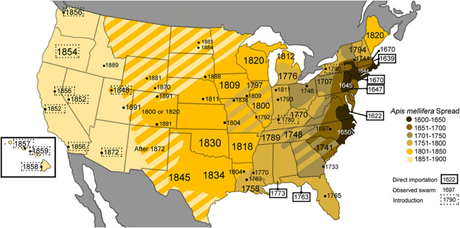Genetic past, present, and future of the honey bee (Apis mellifera) in the United States of America
Madeline H. CARPENTER, Brock A. HARPUR Department of Entomology, Purdue University, West Lafayette, IN, USA Received 2 July 2020 – Revised 27 November 2020 – Accepted 15 December 2020
Abstract – Humans have domesticated hundreds of animal and plant species for thousands of years. Artwork, archeological finds, recorded accounts, and other primary sources can provide glimpses into the historic management practices used over the course of a given species’ domestication history. Pairing historic data with newly available genomic data can allow us to identify where and how species were moved out of their native ranges, how gene flow may have occurred between distantly related populations and quantify how selection and drift each contributed to levels of genetic diversity. Intersecting these approaches has greatly improved our understanding of many managed species; however, there has yet to be a thorough review in a managed insect. Here, we review the archival and genetic history of honey bees introduced to the mainland United States to reconstruct a comprehensive importation history. We find that since 1622, at least nine honey bee subspecies were imported from four of the five honey bee lineages and distributed en masse across the country. Many imported genotypes have genetic evidence of persisting today and may segregate non-randomly across the country. However, honey bee population genetic comparisons on the nationwide scale are not yet feasible because of gaps in genetic and archival records. We conclude by suggesting future avenues of research in both fields.

Apidologie (2021) 52:63–79
We are here to share current happenings in the bee industry. Bee Culture gathers and shares articles published by outside sources. For more information about this specific article, please visit the original publish source: https://link.springer.com/content/pdf/10.1007/s13592-020-00836-4.pdf






